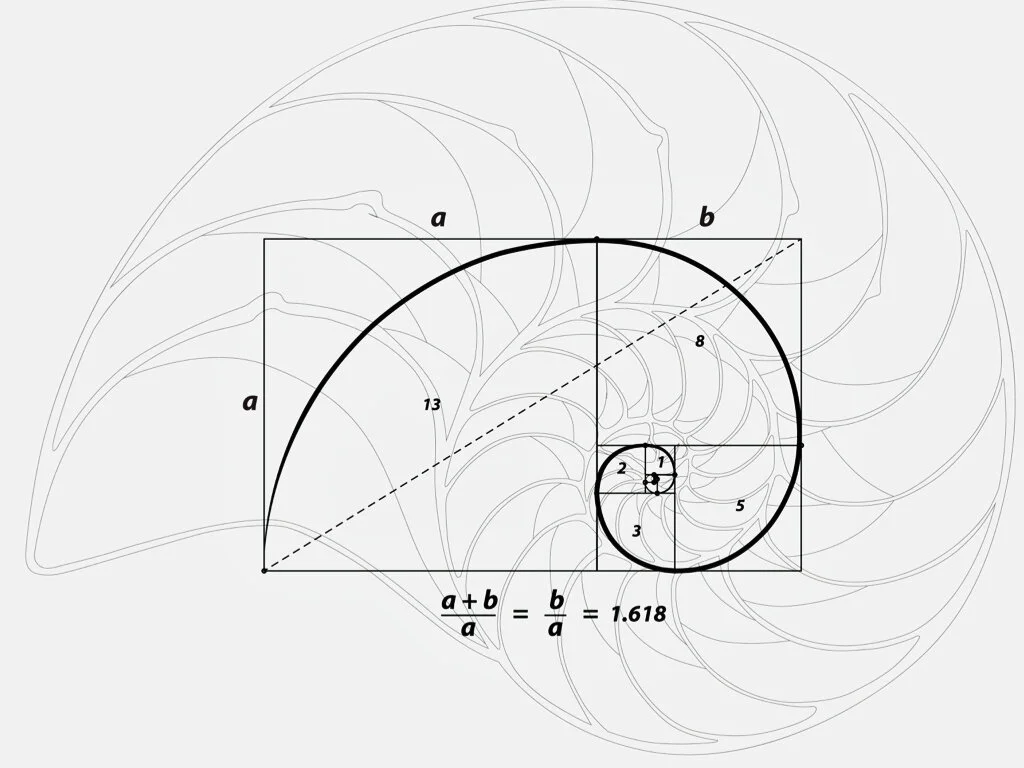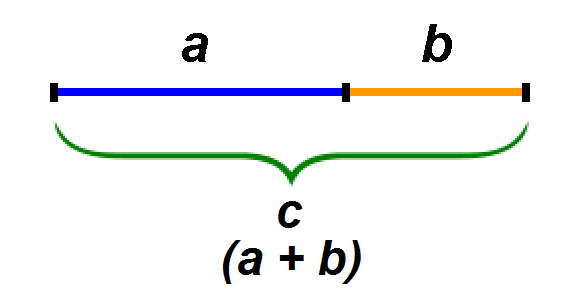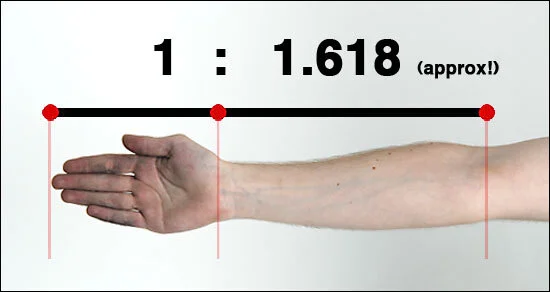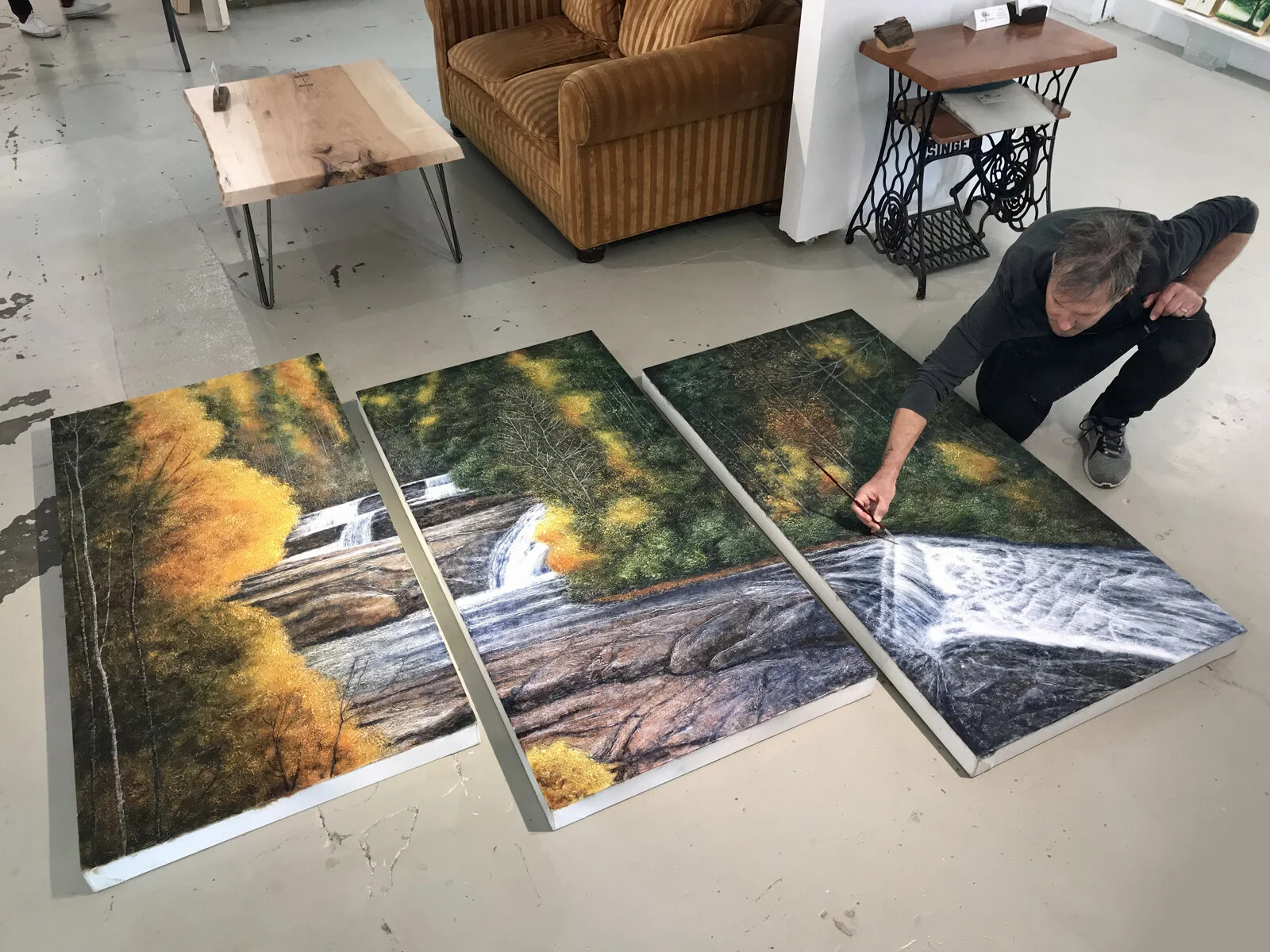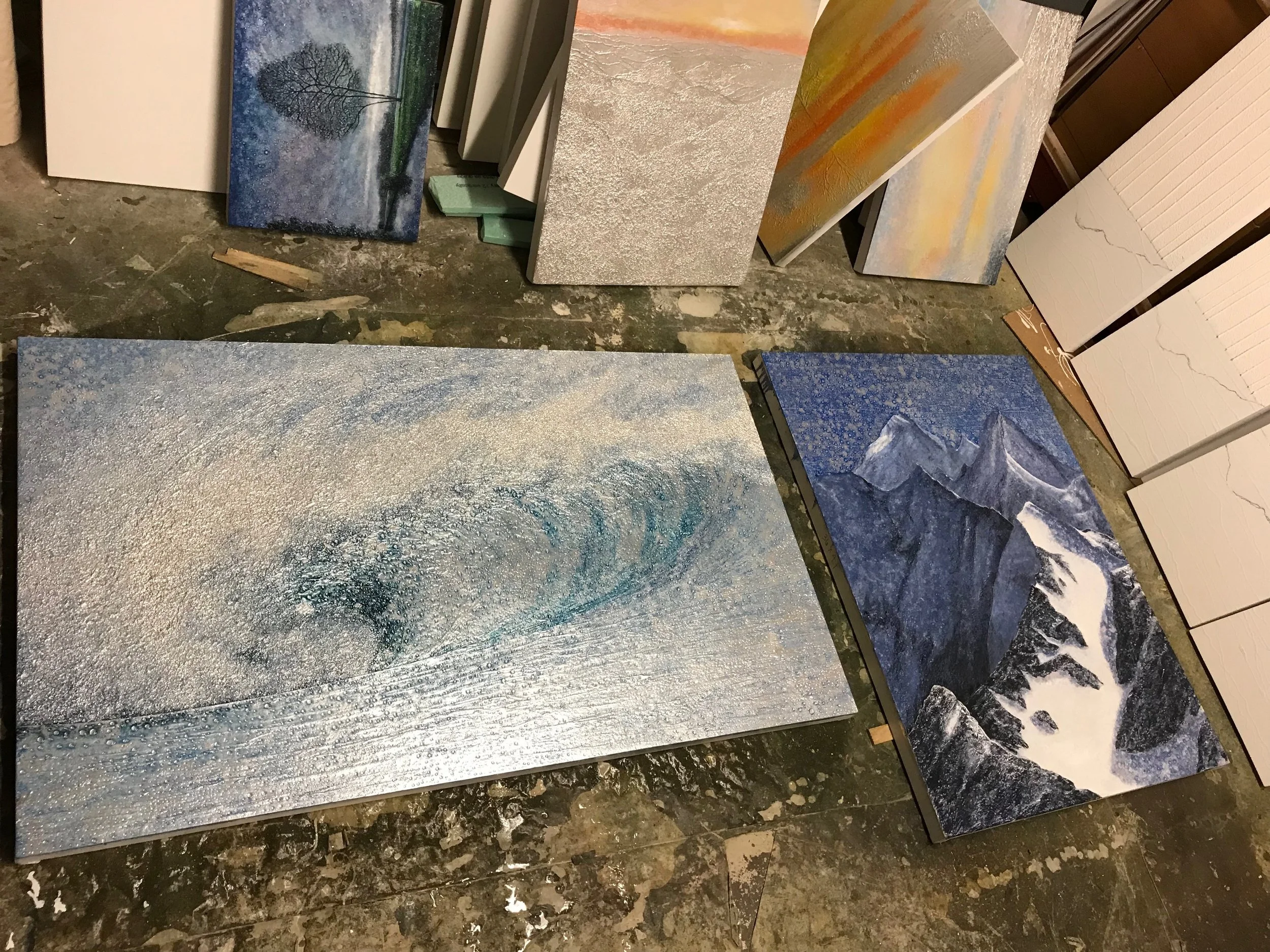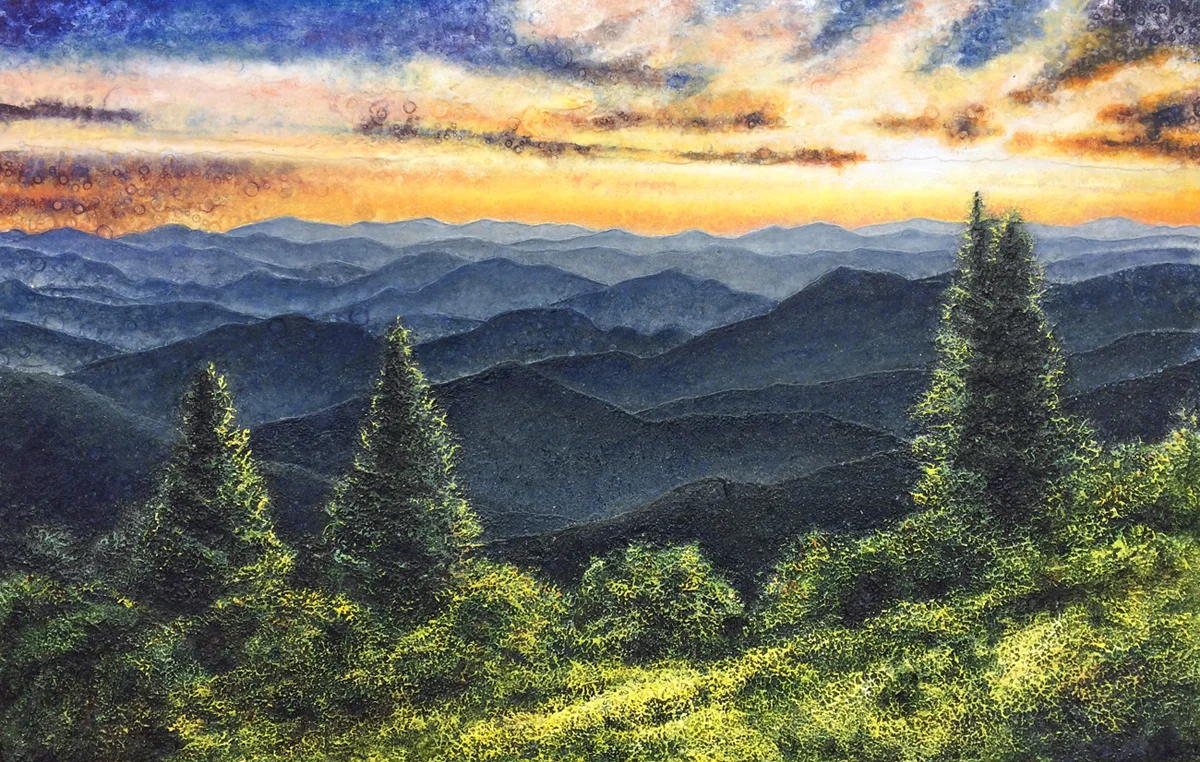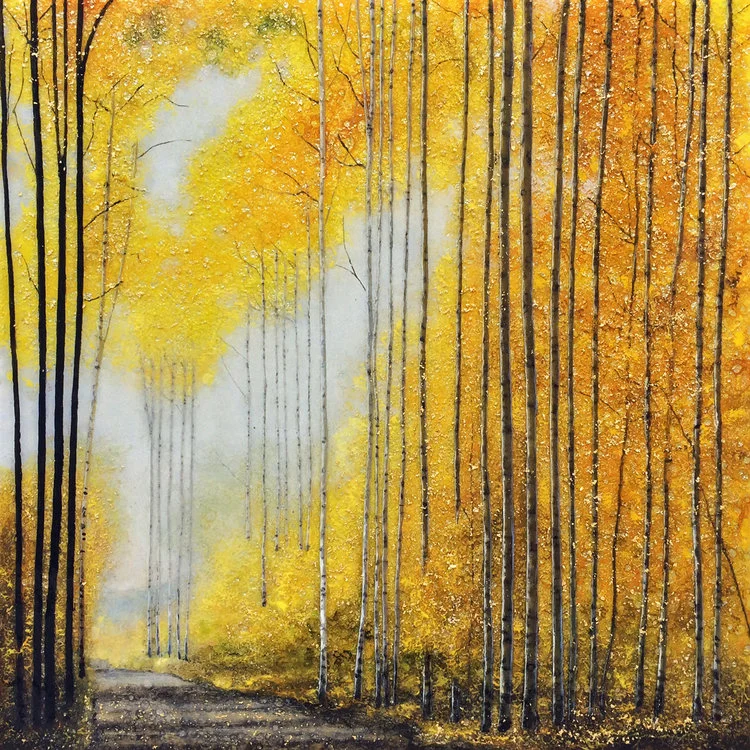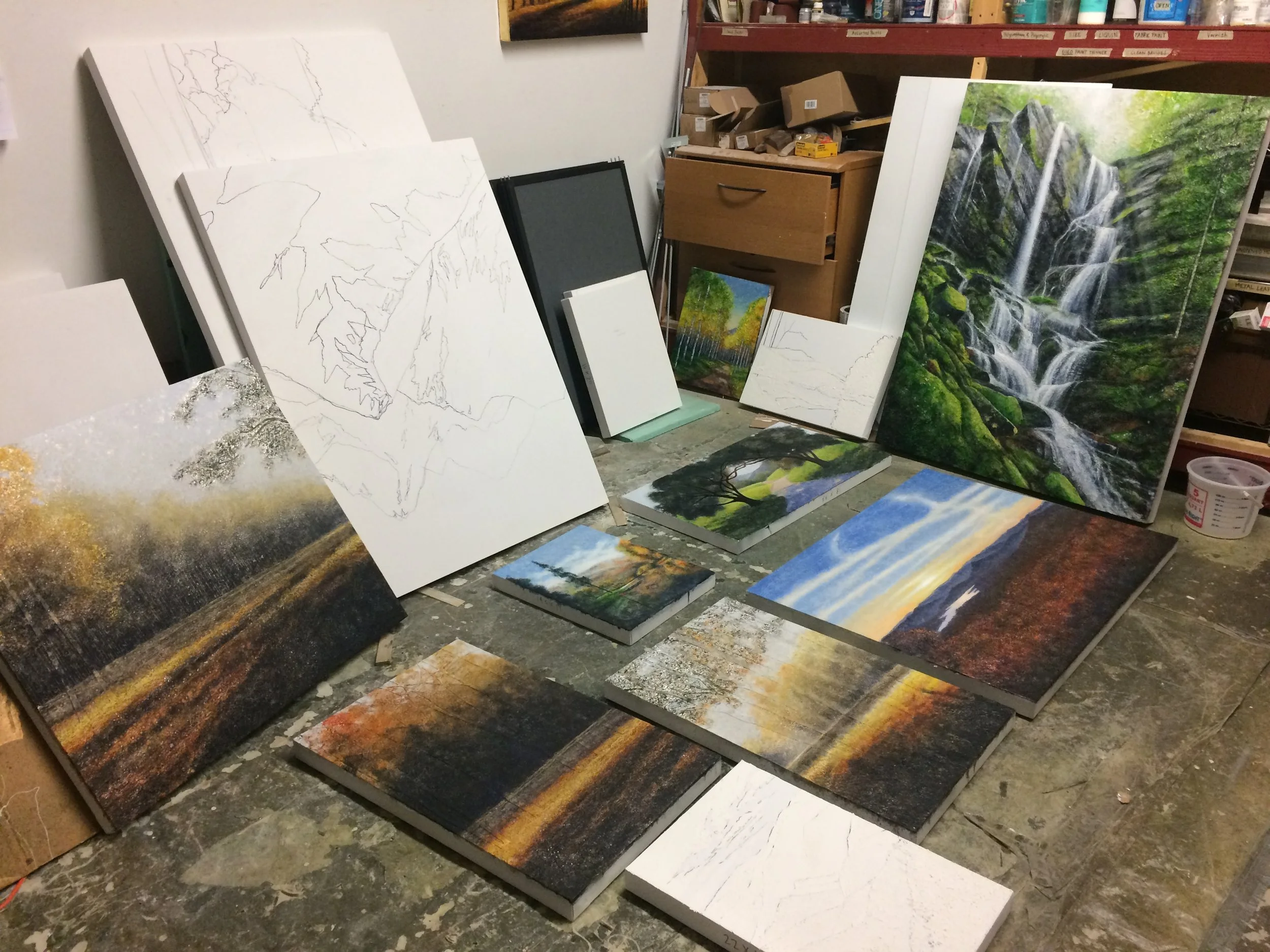
Art Blog
This blog is for posting photos of new art pieces and the random thoughts of oil painter Stephen St. Claire.
Exploring the Golden Ratio in Art
The Golden Ratio, also known as the Divine Proportion or Phi (about 1.618), has captivated artists, architects, and mathematicians for centuries. This mathematical concept is celebrated for creating harmony and aesthetic appeal in various art forms. But how do artists use the Golden Ratio? Let's explore its fascinating applications.
The Golden Ratio comes from the Fibonacci sequence, where each number is the sum of the two before it (0, 1, 1, 2, 3, 5, 8, 13, etc.). As the sequence progresses, the ratio between successive numbers gets closer to the Golden Ratio (1.618). This unique proportion means the whole is to the larger part as the larger part is to the smaller, creating a visually pleasing effect.
The Golden Ratio has ancient roots, particularly in Greek culture, where mathematicians like Euclid and Pythagoras explored its properties. It gained prominence during the Renaissance, with artists like Leonardo da Vinci and Michelangelo using it in their masterpieces. The Vitruvian Man and the composition of The Last Supper are prime examples of the Golden Ratio creating balance and harmony.
How Artists Use the Golden Ratio
Artists often use the Golden Ratio to divide their canvases into appealing proportions. By placing focal points along the Golden Ratio lines, they create compositions that naturally attract the viewer's eye. This technique is found in classical paintings, photography, and modern graphic design, helping to achieve balance and elegance.
The human body is a central subject in art, and the Golden Ratio helps achieve idealized proportions. Leonardo da Vinci's Vitruvian Man is a perfect example, with the human form mapped according to the Golden Ratio. This principle helps artists create balanced and naturally pleasing figures.
The Golden Ratio extends beyond visual art into architecture and design. Iconic structures like the Parthenon in Athens, the Egyptian pyramids, and modern buildings like the Guggenheim Museum in New York use these proportions. This application is also found in everyday objects, from furniture to logos, ensuring functionality and visual appeal.
The Golden Ratio appears in nature too, not just human creations. Spiral patterns in shells, leaf arrangements, and even animal body proportions follow this ratio. Artists often draw inspiration from these natural examples, creating works that resonate with the beauty of the natural world.
The Golden Ratio's allure lies in its ability to create harmonious and balanced compositions. By understanding and applying this ratio, artists can enhance their work's aesthetic quality, drawing viewers in with a sense of natural beauty and proportion. Whether in ancient sculptures, Renaissance paintings, or contemporary designs, the Golden Ratio remains a timeless tool in the artist's toolkit.
How to Create the Perfect Painting
“Your compositions seem…comfortable,” said a recent studio visitor. He went on, wondering out loud, “I’m not sure what I even mean. They have nice proportions”. Little did this gentleman know, but he just wandered into one of the subjects I truly geek out over: the Golden Section. Look it up. You’ll probably geek out too. It’s the secret to perfect proportions.
This is not just some ancient and obscure math formula. It is literally the language by which the universe was designed.
As a kid, I hated math. It was dry, dead and boring. But as I grew up, I came to realize that math was handy. You can balance a checkbook (if you really need to) with math. I had no idea that math could actually be elegant and beautiful. With math, you can construct perfection. With math, you can design using the the Golden Section (also called the Golden Mean and Divine Proportion). What is the Golden Section? Imagine a line (C) that is cut into two sections: a longer section (A) and a shorter section (B). When the ratio of the whole line (C) to the longer segment (A) is equal to the ratio of the longer segment (A) to the shorter segment (B), THAT ratio is the golden section. It is the ratio: 62:38 or 1:1.618.
This is not just some ancient and obscure math formula. It is literally the language by which the universe was designed. That’s a really big deal. Let me illustrate.
If you take the average height of a human and divided it into two (using the golden section), you locate the navel.
If you take the average distance from your shoulder to you fingertips and divide your arm into two sections (using the golden section), you locate your elbow. Divide the distance between your elbow and your fingertips (using the golden section) and you locate your wrist. Keep dividing and you locate each knuckle all the way to the end.
If you take the length of a dolphin, and divide it into two (using the golden section), you locate the dorsal fin.
The Golden Section was used to design the footprint for the pyramid complex of Giza as well as the actual shape of the pyramids. See, if you draw a ling straight down from the tip of the pyramid to the ground, and then from that point to the outside edge of the pyramid, THAT is the golden section. This ratio was used in the design of the parthenon and the Arc of the Covenant in the Bible, and innumerable cathedrals constructed over the centuries.
This ratio is even found in nature. If you take the distance from the sun to the orbit of Venus, and divide that distance in two (using the golden section), you locate the orbit of Mercury. If you take the distance from the sun to Earth and divide that distance in two (using the golden section), you locate the orbit of Venus. This works clear out to the orbit of Venus. You can even see the Golden Section in the spacing of the rings of Saturn.
So what? Well, for some reason, that proportion is the “gold standard” of pleasing proportions. The closer to that proportion you get, the happier your eye will be. And so, knowing that, find a painting or photo you really like. It could be depicting nature or architecture. If that photo is “pleasing to look at”, chances are, the Golden Section is all over it like an invisible scaffolding holding up the visible artwork (or edifice).
Because of all this, I am regularly using math to plan my compositions. Take the height of my painting, say 24”. To locate the horizon, I’ll calculate 38% of that total distance, and draw the horizon line 9-1/8” up from the bottom. To locate the tall tree I want as the focal point of the painting, I’ll draw a line over from the edge that is 38% of the overall width of the canvas. Using this ratio as a guide, I’m sure to design a painting that will eventually be proportioned as close to perfection as I can get it. The rest is just slapping some paint in the right places and voila, a perfect painting! Easy, right?
A Really Unique Commission Project
“Triple Falls Triptych” (30” x 60” — each panel)
I love artwork commissions. I’ve found that as an artist, a commissioned painting oftentimes gives me the opportunity to paint something really unique. I’ve painting the canals of Venice, the Alps, Queenstown Harbour in New Zealand, Jasper National Park in Alberta, British Columbia, and even an Antarctic scene!
Several weeks ago now, a nice local couple came to visit me in my Asheville arts studio and liked what they saw. After several minutes of discussion about commissioning possibilities, they went home to look through their photos. In the mean time, I looked through some of mine.
So, I played God just a bit…
The idea they came up with was partially determined by the eventual location where the artwork would be installed: a stairwell. So here was the assignment: “We’d like a triptych, and we’d like the panels to be offset from each other, each one mounted a bit lower than the previous as they move down the steps. Basically, we’d like a local scene that can, in a sense, move down the wall with the stairs.”
Applying the finishing touches to the panels
SO… if they wanted a scene that “moved down” a stairwell, then one idea immediately came to mind: Triple Falls. Triple Falls is one of the most accessible, iconic and truly majestic waterfalls in western North Carolina, only an hour away from Asheville. But, as I looked at all the photos of the falls, I saw I problem. The waterfall moved from right to left as it cascaded down the mountain. But their stairwell goes down from left to right. So, I played God just a bit and flipped the photo. Viola! Perfection!
What Was Art School Like?
Art Center College of Design, Pasadena, CA
The other day, a family of five came into my art studio in Asheville. They’d been browsing in and out of the different art studios in the River Arts District and had a lot to say about the artwork they’d seen and artists they’d met. Super nice people. This couple’s son said he was interested in pursuing art as a career and Jim (the dad) asked me if I’d been to art school for training and if so, what was it really like? Was it worth it? Oooooo. Good blog post idea!
So, I’ll try to condense what was a half hour conversation into a short blog.
I really think that if it’s the “right” art school, it can be really valuable to an artist. “Self-taught” is fine, don’t get me wrong. No one taught me the technique I’m known for in my artwork. I made it up. But…I made it up using the tools I got from my education. I went to Art Center College of Design in Pasadena, CA. It was extraordinarily challenging but was definitely an amazing experience. I absolutely loved college. One of the things I learned there was to be organized with my time (a valuable tool I’ve used ever since). The work load was so intense and the pressure on the students was incredible. The years I attended, Art Center was ranked #2 (right behind Harvard School of Law) in terms of stress level on the students.
“Crit time” reduced us college students to tears…”
This was also the place I learned to take artistic criticism. I had to either learn to take critique or emotionally crumble! See, upon completion of our assignment, we would post our work on the walls around the classroom. Then we’d each present our assignment, and each of the other students would take turns expressing what was right and what was wrong with what we’d done. There was none of this “now remember, with art, there are NO MISTAKES”. Don’t believe it. “Crit time” reduced us college students to tears. It was brutal and really, really helpful (if you opened up to listening).
The other really helpful thing we learned was about the correct way to compose a piece of art. Did you know there are good and bad color combinations and good and bad compositions for a painting? Oh yes. We learned color theory and we learned about the laws (google "the Golden Section” sometime) that govern makes a pleasing composition of a piece of art. When I got to this point, Jim (the dad in my now captive audience) asked “What about abstract art? Would those rules apply to types of art other than landscapes or still life?” Oh my gosh, YES. Color and good composition are all you have with an abstract painting. Knowing the rules is even MORE important in an abstract.
My time at art college was amazing. I so appreciate the instructors, the brutal critique (though I didn’t enjoy that at the time) and the awesome life-long friends I made there. Because of all that, I’m able to now paint full-time and live in an awesome place like Asheville (and talk to nice families coming into my art studio asking me about my experience at art school. :)
"How do you decide what to paint?"
One of the questions I regularly get asked from visitors to my art studio in Asheville is “where do you get all these ideas to paint? Have you been to all these places?” My answer varies but basically, I explain that no, I have not necessarily been to all these places, though I have been to some of them and I’m always taking photos. “Oh,” they’ll respond, “so you work from photos then?” Yes. About half the things I paint are inspired by photos I’ve taken or received from a client. I find I especially lean on a photo if it’s a commissioned piece of art from someone who has something specific in mind. The rest of what I paint basically reflect the happy places in my head.
“Because this is my job, I have to paint
mostly what I think people will purchase…”
Because I’m a full-time artist, I need my work to sell so I’m always listening to the people that visit my studio (even when they’re whispering to each other — yes, I can hear you sometimes!). This is SUPER helpful to me because I know what is really resonating with people. When I paint something new and hang it on the wall and it gets a ton of attention, loud sirens and blinking red lights go off in my head: PAINT MORE LIKE THIS! So I do. Because this is my job, I have to paint mostly what I think people will purchase in my River Arts District art studio by visitors coming to Asheville for a vacation. So most of my paintings are local or generic scenes. That said, I’m most excited right now about two really impractical pieces of art I started thinking about last winter: A 3’ x 6’ single crashing wave and a 3’ x 5’ scene featuring a composition of towering, jagged Himalyan mountain peaks.
What does a crashing wave or jagged mountains have to do with Asheville, North Carolina? Nothing. “Don’t you want these to sell?” you ask. Well, yes I want them to sell but I don’t care if these two sell or not. See, every now and then, I think it’s important that you express something really personal and distinctly “you”, whether or not anyone else ever appreciates it. Maybe these paintings won’t sell, and that’s okay. That said, these two are thankfully getting a ton of attention as I’m working on them, so that’s really encouraging. I’ll post the completion photos here when the time comes.
Close up of silver leaf wave.
Interior shot of my wave (with the first layer of paint) and the mountain scene.
"Frankenstein-ing" a painting
One afternoon last autumn, Joy and I had a hankerin’ (Southern for “urge”) to pack a picnic and watch the sunset. So we stopped at the store and grabbed what is now “standard picnic fare”: a roasted chicken, whole wheat rolls, potato salad, a bottle of decent wine and Pim’s (for dessert). It was somewhat cloudy that day but the afternoon seemed clearer than the morning, so this was one of those evenings I wasn’t sure about the weather but it was still worth taking a chance. In short, it was wonderful (but cloudy). We drove up onto the Blue Ridge Parkway and headed south (toward Smoky Mountain National Park). About a half hour drive from Asheville, we found a good west-facing turn out and parked the car and feasted, enjoying the muted sunset and the peace and quiet of the place. I took several photos, always hoping for the sun to break through but alas, that evening the sun was a “no show”.
That’s the really great thing about being an artist: we get to “play God” every now and then…
That’s how it goes sometimes. I had what I thought was a great composition in my photos but just not the perfect lighting because of the clouds. So, in looking at my photos afterwards, I concluded it was the right composition for a painting but the wrong sky. What to do, what to do…
That’s the really great thing about being an artist: we get to “play God” every now and then. It occurred to me that I could use an older photo of a really beautiful sunset I had taken on my walk home from my art studio in Asheville’s River Arts District. The sunset was gorgeous, but the foreground was the French Broad River (nice enough) and the New Belgium brewery (also, nice enough but…uh…not “painting” worthy. So…I decided this was a chance to do a bit of artistic “Frankenstein-ing”: taking a bit of this and a bit of that and combining it into one piece, add 10,000 volts of electricity (just kidding) and VIOLA! IT’S ALIVE! (Just kidding.)
So the photo of the painting you see pictured here is from two very separate experiences I had with nature. One in May of 2017 and one in September 2018. There. Now you know my secrets. I unabashedly (and quite regularly) combine foregrounds, midgrounds and backgrounds of photos I take (or find) and create (with the addition of 10,000 volts of electricity — just kidding) a new and unique piece of art.
That’s how we roll here. That’s how we roll.
"How do you Decide What to Paint?"
The other day, I had a really nice couple visit my Asheville art studio from northern Ohio. They spent a good deal of time looking at all my work and were obviously connecting with it. That “connection” makes me feel a sense of accomplishment because this is obviously my goal. After a good while perusing my paintings, they came up to my workstation in the front of my studio and asked, “How do you decide what to paint? I feel like I can just walk into each piece. How do you do that?" Oh gosh, I love questions like that. Usually the questions are nit-picky technical questions inquiring about the precise steps involved in my process (I don’t share those by the way) and addressing those questions all day long can be tiring. But THIS question made me smile. This gets to the heart of the matter. A cool technique might be interesting, but unless a painting “draws you in”, that painting will not sell. And as a professional full-time artist, I sorta need my work to sell and so this issue is something in the forefront of my mind as I’m considering what to paint next.
A cool technique might be interesting, but unless a painting “draws you in”, that painting will not sell.
When I have no idea what to paint next, I browse through all my old photos from various hikes and vacations we’ve taken over the years. The thing is, I some really awesome photos in my files that, while they are really nice photos, would make really boring paintings. One of the key things I look for is whether or not I’m “drawn in” to the composition. If you look through my landscape portfolio on this website, you’ll notice I often employ a pathway of some sort, whether it’s a road or footpath or something in between. I do that because that is such a simple way to invite the viewer into a painting: “Come down this pathway and see what’s around the corner!"
If I want to really accentuate the invitation, I’ll throw in a few sun rays. Sun rays are magical. In a dark, silent forest on a long-forgotten footpath, rays of sunlight up ahead beckon you on.
The other issue is that honestly, every painting I dream up is depicting a place I would personaly like to just go and sit (probably by myself) and listen to the sounds of the place. Maybe for all day. That’s what I’m into. I love being in nature and sensing that call to quiet. I really need more of that. And from what I’ve seen in my art studio, that “call to quiet” resonates with a lot of people who visit me and view my artwork.
So, combine a path and a few sun rays into a quiet space like that, and then you have it: a painting you want to walk into. It sounds really easy, right? It’s not! What I’ve explained in a couple of paragraphs here takes hours and days sometimes. But when I find what I’m looking for, I always save that idea and eventually, that idea gives birth to a painting that (if done right) will carry someone to a quiet place in a very busy world. I like to feel like that’s important.
Blog Archive
-
2025
- Oct 28, 2025 What can I learn from Makoto Fujimura in 2025? Oct 28, 2025
- Oct 12, 2025 What can I learn from Pablo Picasso in 2025? Oct 12, 2025
- Oct 10, 2025 What can I learn from Raphael in 2025? Oct 10, 2025
- Oct 8, 2025 What can I learn from Georgia O’Keefe in 2025? Oct 8, 2025
- Sep 28, 2025 What can I learn from Caravaggio in 2025? Sep 28, 2025
- Jul 25, 2025 What can I learn from Thomas Gainsborough in 2025? Jul 25, 2025
- Jul 20, 2025 What can I learn from Leonardo da Vinci in 2025? Jul 20, 2025
- Jul 15, 2025 What can I learn from Michelangelo in 2025? Jul 15, 2025
- Jul 2, 2025 What can I learn from Van Gogh in 2025? Jul 2, 2025
- Jun 25, 2025 What can I learn from Renoir in 2025? Jun 25, 2025
- Jun 23, 2025 What can I learn from Claude Monet in 2025? Jun 23, 2025
- Jun 21, 2025 Using Complimentary Colors for Shading Jun 21, 2025
- Jun 17, 2025 How and When to use Complimentary Colors Jun 17, 2025
- May 30, 2025 Perspective in Art 101: How to Make Your Drawings Pop Off the Page May 30, 2025
- May 26, 2025 How to Really Understand Medieval Art May 26, 2025
- May 22, 2025 Staying Creative May 22, 2025
- May 10, 2025 AT Experience May 10, 2025
- May 3, 2025 Go Take a Walk! May 3, 2025
- Apr 25, 2025 Periods of Art: Mannerism Apr 25, 2025
- Apr 17, 2025 Finding Meaning in the Abstract: Pointers for Understanding Modern Art Apr 17, 2025
- Apr 16, 2025 The Quiet Labor Apr 16, 2025
- Apr 12, 2025 To Art: a Poem Apr 12, 2025
- Apr 5, 2025 The Enchantment of Art Nouveau Apr 5, 2025
- Mar 23, 2025 "What was it like going to art school?" Mar 23, 2025
- Mar 18, 2025 Why I Love the Rococo Period Mar 18, 2025
- Mar 4, 2025 Expressing Joy Through Art Mar 4, 2025
- Feb 28, 2025 The Connection Between Art and Frustration Feb 28, 2025
- Feb 23, 2025 Neoclassicism: Bringing Ancient Style Back to Life Feb 23, 2025
- Feb 18, 2025 On my walk Feb 18, 2025
- Feb 12, 2025 Art at the Very Beginning Feb 12, 2025
- Feb 10, 2025 Monet and Renoir: A Personal Reflection on Their Differences Feb 10, 2025
- Feb 6, 2025 The Fount of Creation: A poem Feb 6, 2025
- Feb 1, 2025 The Connection Between Art and Grief Feb 1, 2025
- Jan 29, 2025 A Journey Through Medieval Art: Stories from the Middle Ages Jan 29, 2025
- Jan 26, 2025 The Story of Art: The Romantic Period Jan 26, 2025
- Jan 16, 2025 The Relationship Between Music and Painting Jan 16, 2025
- Jan 12, 2025 Periods of Art: Baroque Jan 12, 2025
- Jan 11, 2025 Marketing your Artwork Jan 11, 2025
- Jan 7, 2025 Exploring the Golden Ratio in Art Jan 7, 2025
- Jan 3, 2025 Artistic Enlightenment: Lessons from Italy Jan 3, 2025
-
2024
- Dec 29, 2024 Why Travel is Crucial for Unleashing Creativity Dec 29, 2024
- Dec 22, 2024 Steps to Becoming a Full-Time Professional Artist Dec 22, 2024
- Dec 10, 2024 How to Determine Subject Matter for Your Next Painting Dec 10, 2024
- Dec 3, 2024 My Favorite Artist Dec 3, 2024
- Dec 1, 2024 Creativity and Exploration Dec 1, 2024
- Nov 13, 2024 Impressionistic Heroes of Mine Nov 13, 2024
- Nov 10, 2024 "So how do you DO this?" Nov 10, 2024
- Nov 3, 2024 Discovering the Bond Between Nature and Art Nov 3, 2024
- Nov 1, 2024 How Art Can Help Us Cope with Stress Nov 1, 2024
- Oct 27, 2024 How to Select the Perfect Art for Your Home Oct 27, 2024
- Oct 24, 2024 What to Do When You Feel Like Giving Up as an Artist Oct 24, 2024
- Oct 14, 2024 Book Review: The Artist’s Way Oct 14, 2024
- Oct 11, 2024 How to find Inspiration for your art Oct 11, 2024
- Sep 24, 2024 Crafting the Perfect Title for Your Artwork Sep 24, 2024
- Sep 14, 2024 The Worst Advice I’ve Ever Received as an Artist Sep 14, 2024
- Sep 8, 2024 Overcoming Artist’s Block: Practical Tips Sep 8, 2024
- Aug 30, 2024 Exploring Lessons from Vincent van Gogh Aug 30, 2024
- Aug 29, 2024 Why Purchase Original Artwork? Aug 29, 2024
- Aug 25, 2024 How do you determine the best size artwork to purchase? Aug 25, 2024
- Aug 15, 2024 "So, what's this painting worth?" Aug 15, 2024
- Aug 9, 2024 What color art would go best in my home? Aug 9, 2024
- Aug 4, 2024 How to deal with criticism as an artist Aug 4, 2024
- Mar 27, 2024 Question 12: "What do you do when you have a mental block?" Mar 27, 2024
- Mar 27, 2024 New Goals + Winter Months = "Outside the Box" Creativity Mar 27, 2024
- Jan 8, 2024 Question 11: Where do you get inspiration for your work? Jan 8, 2024
-
2023
- Sep 11, 2023 Question 10: "Do you have your work in galleries?" Sep 11, 2023
- Aug 27, 2023 Question 9: "How do you manage the business side of your art business?" Aug 27, 2023
- Aug 20, 2023 Question 8: "Do you advertise?" Aug 20, 2023
- Aug 13, 2023 Question 7: "How do you price your work?" Aug 13, 2023
- Jul 30, 2023 Question 6: "What are the positive points and negative points about having an 'open studio'?" Jul 30, 2023
- Jul 19, 2023 Question 5: "Would you mind critiquing my work at some point?" Jul 19, 2023
- Jul 1, 2023 Question 4: "Would you recommend art school, and if so, how would you find the right one?" Jul 1, 2023
- Jun 24, 2023 Question 3: "Did you go to art school? If so, where?" Jun 24, 2023
- Jun 16, 2023 Question 2: "How long have you been selling your work professionally?" Jun 16, 2023
- Jun 10, 2023 Question 1..."How long have you been an artist?" Jun 10, 2023
- Jun 4, 2023 So, you're thinking about art as a career? Jun 4, 2023
- Mar 3, 2023 "What inspires you as an artist?" Mar 3, 2023
- Feb 15, 2023 Should I buy a completed painting OR commission a painting? Feb 15, 2023
- Jan 23, 2023 "How do you Price Your Work?" Jan 23, 2023
-
2022
- Dec 1, 2022 An Artist in Italy (Part 3) Dec 1, 2022
- Nov 16, 2022 An Artist in Italy (Part 2) Nov 16, 2022
- Nov 8, 2022 An Artist in Italy (Part 1) Nov 8, 2022
- Oct 10, 2022 When Remodeling a Home... Oct 10, 2022
- Aug 22, 2022 How to Handle Failure Aug 22, 2022
- Jun 3, 2022 "What is it like being an artist these days?" Jun 3, 2022
- May 21, 2022 "Are All Artists Introverts?" May 21, 2022
- May 9, 2022 What Makes a Painting a Good Piece of Art? May 9, 2022
- Apr 1, 2022 The Story Behind…"Gentle Showers on a Summer Afternoon" Apr 1, 2022
- Mar 19, 2022 The Story Behind..."Blue Ridge Summer Afternoon" Mar 19, 2022
- Feb 18, 2022 Your Opinion Please... Feb 18, 2022
- Jan 22, 2022 What's in a Compliment? Jan 22, 2022
-
2021
- Dec 25, 2021 My Christmas Present to Joy Dec 25, 2021
- Dec 12, 2021 Deep in the Heart Dec 12, 2021
- Nov 29, 2021 "How do you know you're done with a painting?" Nov 29, 2021
- Nov 1, 2021 Does it Matter What Other People Think of My Art? Nov 1, 2021
- Oct 12, 2021 Creatively Inhaling... Oct 12, 2021
- Aug 31, 2021 More Fun than I Know What to do With Aug 31, 2021
- Aug 13, 2021 “Are You Self Taught?” Aug 13, 2021
- Jul 21, 2021 New Art Gallery on the West Coast Jul 21, 2021
- Jun 23, 2021 "Art from the Heart" vs "Commissioned Art" Jun 23, 2021
- May 28, 2021 More Questions and Answers May 28, 2021
- May 17, 2021 What does Diversity have to do with honest artwork? May 17, 2021
- May 4, 2021 More Questions and Answers May 4, 2021
- Apr 30, 2021 Questions and Answers Apr 30, 2021
- Apr 16, 2021 And the Next Blog Post is... Apr 16, 2021
- Mar 10, 2021 How do you create when you don't feel like creating? Mar 10, 2021
- Feb 11, 2021 "Mullaghmore": The Story Behind the Painting Feb 11, 2021
- Jan 28, 2021 A Look Back to "The Dark Year" Jan 28, 2021
- Jan 17, 2021 Studio Expansion...Hello Northeast! Jan 17, 2021
- Jan 7, 2021 How to Create the Perfect Painting Jan 7, 2021
-
2020
- Dec 1, 2020 A personal answer to a personal question... Dec 1, 2020
- Nov 4, 2020 Using Art to Express my Politics Nov 4, 2020
- Oct 16, 2020 Sometimes, just "having fun" is a good enough reason Oct 16, 2020
- Oct 4, 2020 The Best Painting Delivery Ever... Oct 4, 2020
- Sep 7, 2020 How a Dinky Little Virus Changed my Art Business Sep 7, 2020
- Aug 9, 2020 Adaptation: Survival of the Most Flexible Aug 9, 2020
- Aug 3, 2020 Story Behind the Painting: "Sundown over the Blue Ridge" Aug 3, 2020
- Jul 18, 2020 Cure for Covid blues Jul 18, 2020
- Jul 5, 2020 Where Does it Take You? Jul 5, 2020
- Jun 3, 2020 Story Behind the Painting: Autumn Day on the French Broad River Jun 3, 2020
- May 24, 2020 Story Behind the Painting: Saint-Jean-Cap-Ferrat May 24, 2020
- Apr 30, 2020 Q&A: SESSION TWO Apr 30, 2020
- Apr 22, 2020 Q&A: SESSION ONE Apr 22, 2020
- Apr 8, 2020 What I'll Miss When This Pandemic is Over... Apr 8, 2020
- Mar 20, 2020 Entertaining Angels Unawares Mar 20, 2020
- Mar 8, 2020 In Celebration of Art Mar 8, 2020
- Feb 27, 2020 "The Bridge" Feb 27, 2020
- Feb 8, 2020 The Most Interesting Question of the Year (but it's only February so...) Feb 8, 2020
- Jan 29, 2020 "Can I Watch You?" Jan 29, 2020
- Jan 14, 2020 From Point A to Point Z Jan 14, 2020
- Jan 5, 2020 An Impractical Idea Jan 5, 2020
-
2019
- Dec 17, 2019 My Beautiful Baby on Display Dec 17, 2019
- Dec 3, 2019 Regarding the Selection of an Artistic Theme Dec 3, 2019
- Nov 20, 2019 "What's Your Best Price on This Piece?" Nov 20, 2019
- Nov 13, 2019 A Really Unique Commission Project Nov 13, 2019
- Nov 6, 2019 Fun with Art Scammers Nov 6, 2019
- Nov 3, 2019 "How did you know you wanted to be an artist?" Nov 3, 2019
- Oct 30, 2019 How do you know when a painting is "done"? Oct 30, 2019
- Oct 20, 2019 The piece I had to paint: "Côte d’Azur" Oct 20, 2019
- Oct 18, 2019 Inspiration Everywhere! Oct 18, 2019
- Aug 26, 2019 Contentment vs Restlessness Aug 26, 2019
- Aug 14, 2019 "Why Should I Purchase Artwork?" Aug 14, 2019
- Aug 11, 2019 What Was Art School Like? Aug 11, 2019
- Aug 7, 2019 "The Four Seasons on the French Broad River" Aug 7, 2019
- Jul 30, 2019 Joy Unspeakable Jul 30, 2019
- Jul 7, 2019 Of Mountains and Oceans Jul 7, 2019
- Jul 3, 2019 Lessons I've Learned as an Artist Jul 3, 2019
- Jun 26, 2019 St.Claire Art Opening at the AC Hotel, Asheville Jun 26, 2019
- Jun 23, 2019 "How do you decide what to paint?" Jun 23, 2019
- Jun 5, 2019 One of my All-Time Heroes Jun 5, 2019
- Jun 2, 2019 Regarding "Inspiration" vs "Necessity" Jun 2, 2019
- May 29, 2019 The Best Complement I've Ever Received May 29, 2019
- May 19, 2019 "What are you Working on These Days?" May 19, 2019
- May 5, 2019 "Frankenstein-ing" a painting May 5, 2019
- Apr 17, 2019 The Big Reveal Apr 17, 2019
- Apr 3, 2019 "How do you Decide What to Paint?" Apr 3, 2019
- Mar 27, 2019 "I'm just not making the sales I need!" Mar 27, 2019
- Mar 20, 2019 Making the Most of Mistakes Mar 20, 2019
- Mar 10, 2019 Exploring Austin Galleries, Part 2 Mar 10, 2019
- Feb 25, 2019 Exploring Austin Galleries, Part 1 Feb 25, 2019
- Feb 10, 2019 Progress! Feb 10, 2019
- Jan 23, 2019 Preliminary Photos of my "Sails" Prototypes Jan 23, 2019
- Jan 16, 2019 The Benefits of Slowing Down Jan 16, 2019
- Jan 8, 2019 New Idea Taking Shape Jan 8, 2019
-
2018
- Dec 29, 2018 Looking Back and Looking Ahead Dec 29, 2018
- Dec 19, 2018 Percolating Creativity Dec 19, 2018
- Dec 16, 2018 So then... Dec 16, 2018
- Dec 12, 2018 What if... Dec 12, 2018
- Dec 5, 2018 Recent Projects on my Plate Dec 5, 2018
- Dec 3, 2018 Claude: My Creative Hero and Muse Dec 3, 2018
- Nov 22, 2018 Lessons I've Learned as an Artist Nov 22, 2018
- Nov 12, 2018 Planning for a Second Studio Location! Nov 12, 2018
- Nov 7, 2018 Steps Involved with a Painting Commission Nov 7, 2018
- Nov 4, 2018 How do you stay "balanced"? Nov 4, 2018
- Oct 28, 2018 What makes art "Art"? Oct 28, 2018
- Oct 21, 2018 "How Did You Stumble Across This Type of Artwork?" Oct 21, 2018
- Oct 17, 2018 "A Personal History" Oct 17, 2018
- Oct 14, 2018 Commission Confusion Oct 14, 2018
- Oct 10, 2018 "Aqueous Dream" Oct 10, 2018
- Oct 7, 2018 Beauty in the Center of the Pit Oct 7, 2018
- Sep 30, 2018 Only North Carolina? Sep 30, 2018
- Sep 23, 2018 The Price of Being a Landscape Painter Sep 23, 2018
- Sep 9, 2018 Thoughts on New Directions, New Possibilities Sep 9, 2018
- Aug 29, 2018 SURVEY: GLOSSY OR SATIN Aug 29, 2018
- Aug 22, 2018 Regarding Commissioning a Painting Aug 22, 2018
- Aug 19, 2018 On the Brink of a Huge Failure Aug 19, 2018
- Aug 7, 2018 "The Trail That Never Ends" Aug 7, 2018
- Aug 5, 2018 Inspration Begets Inspiration Aug 5, 2018
- Jul 19, 2018 Rejuvenating Creativity! Jul 19, 2018
- Jul 15, 2018 A Word About Accolades Jul 15, 2018
- Jul 10, 2018 Where it Began Jul 10, 2018
- Jul 4, 2018 Funny Things People Say in an Art Studio Jul 4, 2018
- Jun 29, 2018 "The Time Between Times" Jun 29, 2018
- Jun 27, 2018 World View #8: Post Modernism Jun 27, 2018
- Jun 21, 2018 World View #7: New Age Pantheism Jun 21, 2018
- Jun 12, 2018 A New Opportunity -- A New Idea Jun 12, 2018
- Jun 6, 2018 The Art of Dinner (at the Grove Park Inn) Jun 6, 2018
- Jun 3, 2018 National Geographic?!? Jun 3, 2018
- Jun 1, 2018 World View #6: Modernism Jun 1, 2018
- May 24, 2018 The Art of Dinner (with the Dallas Cowboys) May 24, 2018
- May 13, 2018 Carving Mountains from Scratch May 13, 2018
- May 10, 2018 "Trigger Warning" May 10, 2018
- May 7, 2018 World View #5: Existentialism May 7, 2018
- Apr 29, 2018 World View #4: Nihilism Apr 29, 2018
- Apr 11, 2018 World View #3: Naturalism Apr 11, 2018
- Apr 4, 2018 World View #2: Deism Apr 4, 2018
- Mar 26, 2018 World View #1: Theism Mar 26, 2018
- Mar 23, 2018 A Time to be Disturbed Mar 23, 2018
- Mar 14, 2018 Understanding Art 101 Mar 14, 2018
- Mar 8, 2018 The Organ Mountains Mar 8, 2018
- Mar 7, 2018 "Remember...there are no mistakes with art" Mar 7, 2018
- Mar 2, 2018 The Biltmore Estate Mar 2, 2018
- Feb 21, 2018 How to Make a Living as an Artist (Part 2) Feb 21, 2018
- Feb 12, 2018 How to Make a Living as an Artist Feb 12, 2018
- Feb 4, 2018 How do you create when you don't feel creative? Feb 4, 2018
- Jan 24, 2018 Gallery Representation in Hendersonville! Jan 24, 2018
- Jan 19, 2018 Metalizing the Biltmore Estate Jan 19, 2018
- Jan 15, 2018 Four Seasons on the Blue Ridge Jan 15, 2018
- Jan 11, 2018 About Ice... Jan 11, 2018
- Jan 10, 2018 What's Next? Jan 10, 2018
-
2017
- Dec 20, 2017 Mountain Top Experiences Dec 20, 2017
- Dec 18, 2017 The Power of Mystery Dec 18, 2017
- Dec 7, 2017 Forsyth Park Fountain Dec 7, 2017
- Dec 6, 2017 Angsty or Terrified? Dec 6, 2017
- Dec 4, 2017 To the "Angsty" Artist... Dec 4, 2017
- Dec 3, 2017 "I woudn't pay HALF of what he's asking!" Dec 3, 2017
- Nov 20, 2017 "On the Water" Nov 20, 2017
- Nov 19, 2017 Song of Autumn Nov 19, 2017
- Nov 15, 2017 "Top of the Mountain" Nov 15, 2017
- Nov 5, 2017 "How do you decide what to paint?" Nov 5, 2017
- Nov 2, 2017 "Valley of Shadows" Nov 2, 2017
- Nov 1, 2017 Forest of Autumn Gold Nov 1, 2017
- Oct 25, 2017 Then and Now Oct 25, 2017
- Oct 24, 2017 Catawba Falls Oct 24, 2017
- Oct 18, 2017 "Valley of Shadows" Oct 18, 2017
- Oct 11, 2017 Autumn River Song Oct 11, 2017
- Oct 3, 2017 Autumnal Shift Oct 3, 2017
- Sep 28, 2017 Mystic Summer Morning Sep 28, 2017
- Sep 24, 2017 Valley of Shadows Sep 24, 2017
- Sep 1, 2017 the breakers Sep 1, 2017
- Aug 24, 2017 When the Sun Went Dark Aug 24, 2017
- Aug 17, 2017 Secret Blog Post Aug 17, 2017
- Aug 14, 2017 Waterfalls Everywhere! Aug 14, 2017
- Aug 11, 2017 "Cullasaja Falls" Completion photo Aug 11, 2017
- Aug 8, 2017 Finishing up "My Marathon" Aug 8, 2017
- Aug 1, 2017 One of the Best Days Ever! Aug 1, 2017
- Jul 26, 2017 "Glacial Fractures in situ" Jul 26, 2017
- Jul 24, 2017 Inspiration and Rest Jul 24, 2017
- Jul 18, 2017 Half Baked Ideas... Jul 18, 2017
- Jul 13, 2017 Oaks on the Water Jul 13, 2017
- Jul 9, 2017 Challenged to the Core Jul 9, 2017
- Jul 5, 2017 Boats on the Water Jul 5, 2017
- Jun 30, 2017 Glacial Fractures Jun 30, 2017
- Jun 29, 2017 Winter in the Summer! Jun 29, 2017
- Jun 27, 2017 What's in a Compliment? Jun 27, 2017
- Jun 23, 2017 Thoughts on a Mighty Failure Jun 23, 2017
- Jun 20, 2017 Sunrise on the Mountain Jun 20, 2017
- Jun 14, 2017 The Last Sunset (is that dramatic or what?) Jun 14, 2017
- Jun 12, 2017 Sunset or Sunrise? End or Beginning? Jun 12, 2017
- Jun 9, 2017 At the End of the Day Jun 9, 2017
- Jun 8, 2017 Giverny: My Homage to the Man Jun 8, 2017
- Jun 2, 2017 A Funny Thing Happened at the Studio Today... Jun 2, 2017
- Jun 2, 2017 Sunrise, Sunset... Jun 2, 2017
- May 29, 2017 Color Explosion May 29, 2017
- May 22, 2017 My Largest Painting to Date... May 22, 2017
- May 18, 2017 What to do with 2000 visitors in an art studio... May 18, 2017
- May 9, 2017 My Creative Muse May 9, 2017
- May 3, 2017 Joys of Life May 3, 2017
- Apr 28, 2017 Regarding Art & Beauty Apr 28, 2017
- Apr 25, 2017 Getting Better Acquainted Apr 25, 2017
- Apr 23, 2017 Rainy Sunday Morning Thoughts Apr 23, 2017
- Apr 22, 2017 Personal Thoughts Apr 22, 2017
- Apr 19, 2017 Favorite Hikes (Inspiration in the Making)... Apr 19, 2017
- Apr 15, 2017 Inspiration is Everywhere (some of our favorite hiking trails) Apr 15, 2017
- Apr 9, 2017 "Where should we eat tonight?" Apr 9, 2017
- Apr 6, 2017 Who Else Should We See in the District? Apr 6, 2017
- Apr 1, 2017 Spring in Western North Carolina Apr 1, 2017
- Mar 29, 2017 "Can you really make a living here?" Mar 29, 2017
- Mar 25, 2017 Of Ruination and Rescue Mar 25, 2017
- Mar 21, 2017 How I decide what to paint... Mar 21, 2017
- Mar 18, 2017 Musings of an artist... Mar 18, 2017
- Mar 14, 2017 Winter thoughts Mar 14, 2017
- Mar 13, 2017 "What makes this painting so sparkly?" Mar 13, 2017
- Mar 10, 2017 You're From Where? Mar 10, 2017
- Mar 5, 2017 "No Boundaries" Mar 5, 2017
- Mar 3, 2017 Appalachian Trail Mar 3, 2017
- Mar 2, 2017 What is 'good' art? Mar 2, 2017
- Feb 26, 2017 A Trip to the Art Museum Feb 26, 2017
- Feb 23, 2017 "The Rules" of Art Feb 23, 2017
- Feb 15, 2017 To School or Not to School... Feb 15, 2017
- Feb 10, 2017 How Do I Start This Thing? Feb 10, 2017
- Feb 9, 2017 Rocky Mountains reflection Feb 9, 2017
- Feb 7, 2017 Getting Inspired Feb 7, 2017
- Feb 5, 2017 Inspiration for a painting... Feb 5, 2017
- Jan 31, 2017 Understanding Abstract Art Jan 31, 2017
- Jan 29, 2017 Chi Jan 29, 2017
- Jan 26, 2017 Process: Rocky Mountain Commission Jan 26, 2017
- Jan 12, 2017 "Summer Path Thru the Birch Trees" Jan 12, 2017
- Jan 9, 2017 "Daybreak" Jan 9, 2017
-
2016
- Dec 31, 2016 Revisiting a friend Dec 31, 2016
- Dec 28, 2016 The Trial Run Dec 28, 2016
- Dec 17, 2016 Asheville Channel Interview Dec 17, 2016
- Nov 28, 2016 "Big Mamma" begins to sing.... Nov 28, 2016
- Nov 22, 2016 An Experiment with Moonlight Nov 22, 2016
- Nov 17, 2016 Transfiguration Nov 17, 2016
- Nov 11, 2016 My Cluttered World Nov 11, 2016
- Oct 30, 2016 Sacred Space Oct 30, 2016
- Oct 22, 2016 Omikron (Fire & Ice) Oct 22, 2016
- Oct 19, 2016 "Do you know what you're going to paint?" Oct 19, 2016
- Oct 15, 2016 "Golden Pathway" Oct 15, 2016
- Oct 14, 2016 Flowers, Flowers Everywhere Oct 14, 2016
- Oct 13, 2016 OKC 2 ("The Bridge") Oct 13, 2016
- Oct 12, 2016 Headed west... Oct 12, 2016
- Sep 7, 2016 A Year of "Largest" Sep 7, 2016
- Aug 2, 2016 Transformation of an idea... Aug 2, 2016
- Jul 27, 2016 Beginning my "marathon" painting: Cullasaja Falls Jul 27, 2016
- Jul 18, 2016 My Marathon Jul 18, 2016
- Jul 13, 2016 Welcome! Jul 13, 2016
- Jul 11, 2016 Aegean Waters Jul 11, 2016
- Jul 2, 2016 The Red Planet Jul 2, 2016
- Jun 17, 2016 Puzzling and Playing Jun 17, 2016
- Jun 10, 2016 St.Claire Art Studio Tour Jun 10, 2016
- Jun 6, 2016 Hominy Valley Jun 6, 2016
- May 25, 2016 "The Acolytes" is installed in Georgetown, SC May 25, 2016
- May 19, 2016 "Zuma" May 19, 2016
- May 18, 2016 Fishy Art May 18, 2016
- May 13, 2016 "The Journey" May 13, 2016
- May 10, 2016 Hyatt Ridge (26" x 16") May 10, 2016
- May 5, 2016 "Broad River in October" May 5, 2016
- May 2, 2016 A Blast From the Past May 2, 2016
- Apr 22, 2016 Beginnings II Apr 22, 2016
- Apr 21, 2016 Appalachian Panorama Apr 21, 2016
- Apr 18, 2016 "How do you get the aluminum on the painting?" Apr 18, 2016
- Apr 14, 2016 Beginnings Apr 14, 2016
- Mar 24, 2016 St. Claire Art News & Updates Mar 24, 2016
- abstract
- aluminum leaf
- Appalachian Trail
- art as a career
- art business
- art career
- art career advice
- art commission
- art composition
- art creation
- art critique
- art education
- Art Gallery
- art gallery
- art history
- art inspiration
- art marketing
- art movements
- art periods
- art poetry
- art process
- art purchase
- art sales
- art school
- Art Studio
- art studio
- art studios
- Art Studios
- art technique
- artist
- Artist advice
- artist advice
- artist representation
- artisti creation
- artistic expression
- artistic inspiration
- artwork
- Artwork
- Asheville
- asheville
- Asheville art gallery
- Asheville art studio
- Asheville artist
- Asheville artists
- Autumn
- autumn
- birch
- blue
- Blue Ridge
- commission
- Commission
- complimentary colors
- contemporary art
- creative inspiration
- Creativity
- creativity
- cullasaja falls
- fine art
- golden section
- grief
- grove park inn
- Hiking
- impressionism
- inspiration
- installation art
- landscapes
- medieval art
- mountain trails
- mountains
- North Carolina
- ocean
- ocean artwork
- oil painting
- Oil paintings
- origins
- process
- Professional artist
- red
- reflection
- Renoir
- Resin art
- River
- River Arts District
- Statement peice
- studio
- summer
- sunset
- Sunset
- travel
- travel and creativity
- trees
- understanding art
- unique wall art
- water
- waterfall
- wave
- western north carolina
- Western North Carolina
- woods
- World Views


